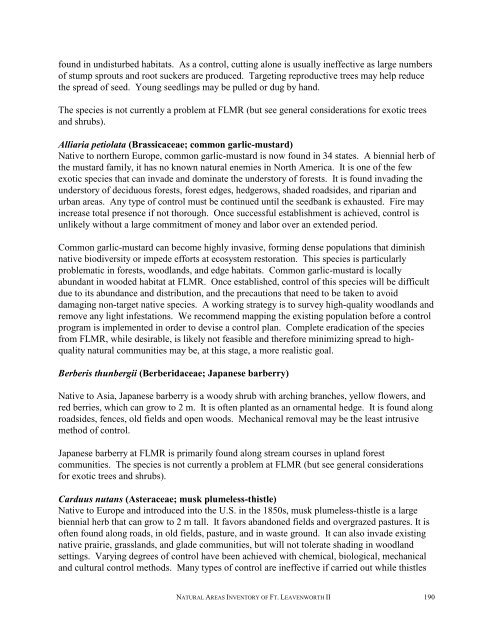A Natural Areas Inventory of the - Kansas Natural Heritage Inventory ...
A Natural Areas Inventory of the - Kansas Natural Heritage Inventory ...
A Natural Areas Inventory of the - Kansas Natural Heritage Inventory ...
Create successful ePaper yourself
Turn your PDF publications into a flip-book with our unique Google optimized e-Paper software.
found in undisturbed habitats. As a control, cutting alone is usually ineffective as large numbers<br />
<strong>of</strong> stump sprouts and root suckers are produced. Targeting reproductive trees may help reduce<br />
<strong>the</strong> spread <strong>of</strong> seed. Young seedlings may be pulled or dug by hand.<br />
The species is not currently a problem at FLMR (but see general considerations for exotic trees<br />
and shrubs).<br />
Alliaria petiolata (Brassicaceae; common garlic-mustard)<br />
Native to nor<strong>the</strong>rn Europe, common garlic-mustard is now found in 34 states. A biennial herb <strong>of</strong><br />
<strong>the</strong> mustard family, it has no known natural enemies in North America. It is one <strong>of</strong> <strong>the</strong> few<br />
exotic species that can invade and dominate <strong>the</strong> understory <strong>of</strong> forests. It is found invading <strong>the</strong><br />
understory <strong>of</strong> deciduous forests, forest edges, hedgerows, shaded roadsides, and riparian and<br />
urban areas. Any type <strong>of</strong> control must be continued until <strong>the</strong> seedbank is exhausted. Fire may<br />
increase total presence if not thorough. Once successful establishment is achieved, control is<br />
unlikely without a large commitment <strong>of</strong> money and labor over an extended period.<br />
Common garlic-mustard can become highly invasive, forming dense populations that diminish<br />
native biodiversity or impede efforts at ecosystem restoration. This species is particularly<br />
problematic in forests, woodlands, and edge habitats. Common garlic-mustard is locally<br />
abundant in wooded habitat at FLMR. Once established, control <strong>of</strong> this species will be difficult<br />
due to its abundance and distribution, and <strong>the</strong> precautions that need to be taken to avoid<br />
damaging non-target native species. A working strategy is to survey high-quality woodlands and<br />
remove any light infestations. We recommend mapping <strong>the</strong> existing population before a control<br />
program is implemented in order to devise a control plan. Complete eradication <strong>of</strong> <strong>the</strong> species<br />
from FLMR, while desirable, is likely not feasible and <strong>the</strong>refore minimizing spread to highquality<br />
natural communities may be, at this stage, a more realistic goal.<br />
Berberis thunbergii (Berberidaceae; Japanese barberry)<br />
Native to Asia, Japanese barberry is a woody shrub with arching branches, yellow flowers, and<br />
red berries, which can grow to 2 m. It is <strong>of</strong>ten planted as an ornamental hedge. It is found along<br />
roadsides, fences, old fields and open woods. Mechanical removal may be <strong>the</strong> least intrusive<br />
method <strong>of</strong> control.<br />
Japanese barberry at FLMR is primarily found along stream courses in upland forest<br />
communities. The species is not currently a problem at FLMR (but see general considerations<br />
for exotic trees and shrubs).<br />
Carduus nutans (Asteraceae; musk plumeless-thistle)<br />
Native to Europe and introduced into <strong>the</strong> U.S. in <strong>the</strong> 1850s, musk plumeless-thistle is a large<br />
biennial herb that can grow to 2 m tall. It favors abandoned fields and overgrazed pastures. It is<br />
<strong>of</strong>ten found along roads, in old fields, pasture, and in waste ground. It can also invade existing<br />
native prairie, grasslands, and glade communities, but will not tolerate shading in woodland<br />
settings. Varying degrees <strong>of</strong> control have been achieved with chemical, biological, mechanical<br />
and cultural control methods. Many types <strong>of</strong> control are ineffective if carried out while thistles<br />
NATURAL AREAS INVENTORY OF FT. LEAVENWORTH II 190


